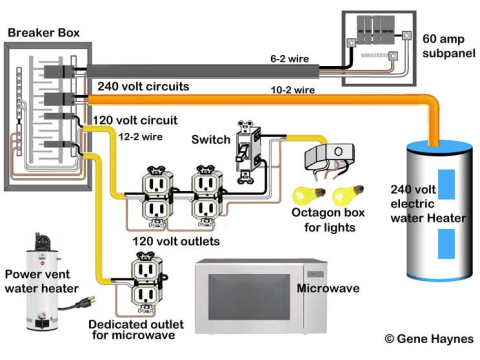Why Does the RCD (GFCI) Trip from Water Heaters and Washers?
When an RCD—often known as a GFCI in the USA—“trips” or “pops,” it generally indicates a leakage current to ground. Here are the main reasons an RCD may suddenly disconnect power:
- Faulty RCD (GFCI) Device
- Incorrect Wiring or Connection
- Damaged or Deteriorated Wiring
- Faulty Appliance—especially water heaters, washing machines, or dishwashers
Below, we’ll break down each of these scenarios and show you how to determine the source of the problem—focusing on why water heaters and washing machines often trigger RCD (GFCI) protection.
1. The RCD (GFCI) Itself Is Faulty
Sometimes the RCD may have an internal defect, such as a:
- Tripping Mechanism failure
- Differential Detection circuit issue
- Malfunctioning Test button assembly
Since most RCD units are not user-serviceable, a defective one usually must be completely replaced. This diagnostic approach also applies to an RCBO (a device combining breaker and RCD functions).
1.1 How to Test If the RCD Is Defective
- Turn Off the Main Breaker (or service disconnect) to ensure safety.
- Disconnect the load-side wires from the RCD’s output terminals.
- Restore Power and switch the RCD to the ON position (with no load attached).
- If the RCD still trips immediately, it’s very likely defective and needs replacement.
2. Improper Wiring or Connection
If the RCD trips right after initial installation, incorrect wiring could be to blame. Check for:
- Miswiring of hot and neutral
- Line vs. Load reversal
- Shared neutrals on the load side
- Any bridging or jumpering that shouldn’t be there
Note: If your system worked fine for a significant period and then started tripping, a wiring mistake is less likely. It’s still good to verify connections match both manufacturer instructions and local code requirements.
3. Faulty or Damaged Electrical Wiring
If the RCD trips even with no appliances connected (i.e., no load) and passes the test in Section 1 above, it could indicate a leakage current within the building’s wiring:
- Moisture or physical damage in the cables
- Worn insulation in walls or conduits
- Incorrect or loose connections behind receptacles or in junction boxes
These wiring issues are often time-consuming to locate, as you may need to inspect or test each circuit. Make sure all appliances are unplugged (not just turned off) to confirm the wiring alone is the culprit.
4. Appliance-Related Problems: Water Heaters and Washers
Water heaters, washing machines, and dishwashers frequently trigger RCD tripping because they rely on heating elements or motors operating in a wet environment. Even minor insulation flaws can permit current leakage to the appliance’s metal housing.
4.1 Typical Symptoms
- Immediate Trip upon plugging in the appliance
- Trip only when the heating element activates (e.g., the water heater starts heating, or the washer enters a hot-water cycle)
- Occasional Trips correlating with higher humidity or usage frequency
With Proper Grounding
The RCD may trip as soon as you turn on the appliance because leakage flows from the metal enclosure through the ground conductor. This is safer, as the RCD intervenes before someone touches the energized housing.
Without Proper Grounding
An RCD can still trip immediately if there’s a low-resistance path to a natural ground source, like plumbing or metal structures. Otherwise, it trips when a person touches the faulty enclosure, drawing current through their body—though usually for just a split second before the RCD cuts power.
4.2 Distinguishing the Faulty Appliance Component
Sometimes the fault lies in the power cord or plug rather than the internal electronics. If the RCD trips simply by plugging in an appliance—without even turning it on—check:
- Plug (loose or burnt terminals)
- Cord (nicks or crushed insulation)
With washing machines or dishwashers, heating elements can be the main culprit if they’re partially shorting to the metal tank or chassis. In water heaters, the immersion heater can degrade over time, creating a small leakage path.
Diagnostic Summary
- Check the RCD First
- Disconnect all load wires. If the RCD trips, it’s faulty and must be replaced.
- Review Wiring
- Confirm correct line/load orientation, no shared neutrals on the load side, and adherence to code.
- Inspect the House Wiring
- If tripping still happens with the load disconnected, look for damaged or moist wires.
- Appliance Testing
- Plug appliances back in one by one (physically remove them from the circuit to eliminate them).
- An appliance that triggers the RCD when plugged in or switched on likely has internal leakage.
Key Points to Remember
- Water heaters and washing machines frequently involve heating elements under wet conditions, making them prime candidates for leakage current.
- Immediate tripping often indicates a direct ground fault (via grounded housings or conductive plumbing).
- Any RCD or RCBO issues can also stem from the device being inherently defective or from miswiring.
- Appliance cords can be the culprit; check them first if plugging in the machine alone causes the RCD to pop.
Tip: For deeper guidance on RCD (GFCI) selection, wiring methods, and troubleshooting, visit safsale.com—your go-to resource for American electrical safety best practices.
By systematically testing each stage—RCD device, wiring integrity, and each appliance—you can pinpoint why the RCD keeps tripping and resolve the root cause efficiently, restoring safe, uninterrupted operation.

